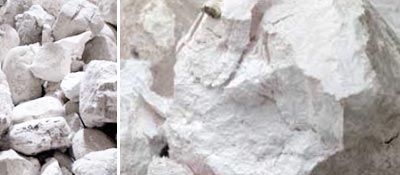
CREATING LIME
Furnace: the firing

The smaller limestone is separated to obtain a load of the same similar size and, as a consequence, an homogenous cooking of the limestone.
They are loaded from the stone inlet at the top of the kiln, from where they will slowly go down to the firing zone passing through the first pre-heating zone.

The cooking of the stones is very slow and constant, about 7 days at an average temperature of 900°C (1650°F).
During this phase the calcium carbonate and magnesium carbonate release the carbon dioxide contained in them, the stones lose up to one third of their weight.
What we obtain is a caustic substance, unstable, highly hygroscopic, called calcium oxide (and magnesium oxide) also known as quick lime.

After the cooking the limestone is sorted again, in order to eliminate those stones not completely converted into oxides or the “stracotte” (overcooked); these byproducts of the kiln, thanks to their dark color and hardness, are used by expert artisans, like in the ancient times, to make beautiful mosaics or “seminati” floor, a typical Italian decorative floor of the Middle-ages for masonries.


